Evolution of Soil Chemical Fertility in an Area under Recovery for 30 Years with Anthropic Intervention
Abstract
1. Introduction
2. Materials and Methods
3. Results and Discussion
4. Conclusions
Author Contributions
Funding
Institutional Review Board Statement
Informed Consent Statement
Data Availability Statement
Acknowledgments
Conflicts of Interest
References
- Fardin, F.H.; Maltoni, K.L.; Boni, T.S.; Faria, G.A.; Rezende, A.A. Restauração ecológica de subsolo exposto condicionado com resíduos no Cerrado. Sci. For. 2021, 49, e3452. [Google Scholar] [CrossRef]
- Mota, J.F.; Martínez-Hernández, F.; Salmerón-Sánchez, E.; Mendoza-Fernández, A.J.; Pérez-García, F.J.; Merlo, M.E. Spontaneous Primary Succession and Vascular Plant Recovery in the Iberian Gypsum Quarries: Insights for Ecological Restoration in an EU Priority Habitat. Plants 2023, 12, 1162. [Google Scholar] [CrossRef] [PubMed]
- Prach, K.; Walker, L.R. Four opportunities for studies of ecological succession. Trends Ecol. Evol. 2011, 26, 119–123. [Google Scholar] [CrossRef] [PubMed]
- Bonini, C.S.B.; Maciel, T.M.S.; Moreira, B.R.A.; Chitero, J.G.M.; Henrique, R.L.P.; Alves, M.C. Long-Term Integrated Systems of Green Manure and Pasture Significantly Recover the Macrofauna of Degraded Soil in the Brazilian Savannah. Soil. Syst. 2023, 7, 56. [Google Scholar] [CrossRef]
- Neto, A.B.; Bonini, C.D.S.B.; Bisi, B.S.; dos Reis, A.R.; Coletta, L.F.S. Artificial neural network for classification and analysis of degraded soils. IEEE Lat. Am. Trans. 2017, 15, 503–509. [Google Scholar] [CrossRef]
- Kitamura, A.E.; Tavares, R.L.M.; Alves, M.C.; Souza, Z.M.; Siqueira, D.S. Soil macrofauna as bioindicator of the recovery of degraded Cerrado soil. Cienc. Rural 2020, 50, 1–8. [Google Scholar] [CrossRef]
- Giácomo, R.G.; Alves, M.C.; Arruda, O.G.; Souto, S.N.; Pereira, M.G.; Moraes, M.L.T. Atributos químicos de um solo degradado após aplicação de composto orgânico e crescimento de Mabea fistulifera Mart. Cienc. Florest. 2019, 29, 754–768. [Google Scholar] [CrossRef]
- Silva, J.H.C.S.; Barbosa, A.S.; Gomes, D.S.; Aquino, I.S.; Silva, J.R. Dynamics of plant organic matter decomposition in different agricultural landscapes. Rev. Caatinga 2023, 36, 135–144. [Google Scholar] [CrossRef]
- Souto Filho, S.N.; Alves, M.C.; Monreal, C.M.; Bonini, C.S.B. Nanoparticles and nanostructure morphology of a Red Latosol in rehabilitation. Rev. Bras. Eng. Agríc. Ambiental 2017, 21, 530–536. [Google Scholar] [CrossRef]
- Boni, T.; Pujol Pereira, E.I.; Avelino Santos, A.; Rodrigues Cassiolato, A.M.; Maltoni, K.L. Biomass residues improve soil chemical and biological properties reestablishing native species in an exposed subsoil in Brazilian Cerrado. PLoS ONE 2022, 17, e0270215. [Google Scholar]
- Bonini, C.S.B.; Alves, M.C.; Montanari, R. Lodo de esgoto e adubação mineral na recuperação das propriedades químicas de um solo degradado. Rev. Bras. Eng. Agríc. Ambiental 2015, 19, 388–393. [Google Scholar] [CrossRef]
- Mizobata, K.K.G.S. Alterações de Atributos Físicos de Subsolo Revegetado e Condicionado com Resíduos, Para Recuperação de Ambiente Degradado no Cerrado. Master’s Thesis, Faculdade de Engenharia, Universidade Estadual Paulista, Ilha Solteira, Brazil, 2017. [Google Scholar]
- Machado, K.S.; Maltoni, K.L.; Santos, C.M.; Cassiolato, A.M.R. Resíduos orgânicos e fósforo como condicionantes de solo degradado e efeitos sobre o crescimento inicial de Dipteryx alata Vog. Cienc. Florest. 2014, 24, 541–552. [Google Scholar] [CrossRef]
- Machado, P.L.O.A.; Benites, V.M.; Bolan, N. Liming Acidic Soils Recarbonizing Global Soils: A Technical Manual of Recommended Sustainable Soil Management. Available online: http://www.fao.org/documents/card/en/c/cb6595en2021 (accessed on 1 June 2023).
- Matos, A.M.S.; Bonini, C.S.B.; Moreira, B.R.A.; Andreotti, M.; Heinrichs, R.; Silva, D.T.; Souza, J.A.L.; Santos, M.A.; Andrighetto, C.; Pavan, G.M.; et al. Long-Term Integrated Crop–Livestock–Forestry Systems Recover the Structural Quality of Ultisol Soil. Agronomy 2022, 12, 2961. [Google Scholar] [CrossRef]
- Lal, R. Restoring Soil Quality to Mitigate Soil Degradation. Sustainability 2015, 7, 5875–5895. [Google Scholar] [CrossRef]
- Siqueira, C.C.Z. Atributos do Solo E Estoques de Carbono em Sistemas Agroflorestais na Restauração de Áreas Degradadas. Master’s Thesis, Instituto Agronômico, Campinas, Brazil, 2017. [Google Scholar]
- Rossi, C.Q.; Pinto, L.A.S.R.; Moura, O.V.T.; Loss, A.; Pereira, M.G. Soil organic matter in biogenic, intermediate and physicogenic aggregates under agroecological management. Rev. Caatinga 2023, 36, 167–176. [Google Scholar] [CrossRef]
- Teran, F.J.C.; Oliveira Santos, G.; Júnior, W.T.; Freitas, E.C.B.; Soares, J.A. Avaliação da recuperação de áreas degradadas por exploração de cascalho laterítico por meio da incorporação de lodo de esgoto. Estudo de caso no Distrito Federal. Braz. J. Anim. Environ. Res. 2022, 5, 2973–2984. [Google Scholar] [CrossRef]
- Bonini Neto, A.; Bonini, C.S.B.; Reis, A.R.; Piazentin, J.C.; Coletta, L.F.S.; Putti, F.F.; Heinrichs, R.; Moreira, A. Automatic Recovery Estimation of Degraded Soils by Artificial Neural Networks in Function of Chemical and Physical Attributes in Brazilian Savannah Soil. Comm. Soil Sci. Plant Anal. 2019, 50, 1785–1798. [Google Scholar] [CrossRef]
- Araujo, K.D.; Souza, M.A.; Santos, G.R.; Andrade, A.P.; Ferreira Neto, J.V. Atividade microbiana no solo em diferentes ambientes da região semiárida de Alagoas. Geografia 2016, 25, 5–18. [Google Scholar]
- Hoffmann, R.B.; Lima, S.V.; Hoffmann, G.S.S.; Araújo, N.S.F. Efeito do uso do solo sobre a macrofauna edáfica. Braz. J. Anim. Environ. Res. 2018, 1, 125–133. [Google Scholar]
- De Oliveira Silva, M.; Veloso, C.L.; do Nascimento, D.L.; de Oliveira, J.; de Freitas Pereira, D.; da Silva Costa, K.D. Indicadores químicos e físicos de qualidade do solo. Braz. J. Dev. 2020, 6, 47838–47855. [Google Scholar] [CrossRef]
- Albuquerque, A.S.; Fonsêca, N.C.; Santos, R.V. Aplicação de corretivos alternativos em solo salinizado com cultivo de Sorghum bicolor L. Rev. Verde 2018, 13, 452–458. [Google Scholar] [CrossRef]
- Santos, H.G.; Jocomine, P.K.T.; Anjos, L.H.C.; Oliveira, V.A.; Lumbrearas, J.F.; Coelho, M.R.; Almeida, J.A.; Araújo Filho, J.C.; Oliveira, J.B.; Cunha, T.J.F. Brazilian System of Soil Classification (Sistema Brasileiro de Classificação de Solos), 5th ed.; Embrapa: Rio de Janeiro, Brazil, 2018; p. 286. [Google Scholar]
- Soil Survey Staff. Keys to Soil Taxonomy, NRCS, 12th ed.; EUA: Washington, DC, USA, 2014.
- Alves, M.C.; Nascimento, V.; Souza, Z.M. Recovery of nativa area used for construction of hydroelectric power station. Rev. Bras. Eng. Agríc. Ambiental 2012, 16, 887–893. [Google Scholar] [CrossRef]
- Raij, B.; van Andrade, J.C.; Cantarella, H.; Quaggio, J.A. Análise Química Para Avaliação da Fertilidade de Solos Tropicais; IAC: Sao Paulo, Brazil, 2001. [Google Scholar]
- Ferreira, D.F. SISVAR: A computer statistical analysis system. Ciência Agrotecnologia 2011, 35, 1039–1042. [Google Scholar] [CrossRef]
- Cordeiro, S.M.A.; Carneiro, M.A.C.; Paulino, H.B.; Sagging Junior, O.J. Colonização E Densidade De Esporos De Fungos Micorrízicos Em Dois Solos Do Cerrado Sob Diferentes Sistemas De Manejo. Pesqui. Agropecu. Trop. 2005, 35, 147–153. [Google Scholar]
- Rosolem, C.A.; Merlin, A.; Bull, J.C.L. Soil phosphorus dynamics as affected by Congo grass and P fertilizer. Sci. Agric. 2014, 71, 309–315. [Google Scholar] [CrossRef]
- Oliveira, I.P.; Cunha, R.; Santos, R.S.M.; Faria, C.D.; Cunha, G.F. Efeito da correção da fertilidade do solo no desenvolvimento da Brachiaria brizantha cv. Marandu em latossolo com diferentes históricos. Pesqui. Agropecu. Trop. 2000, 30, 57–64. [Google Scholar]
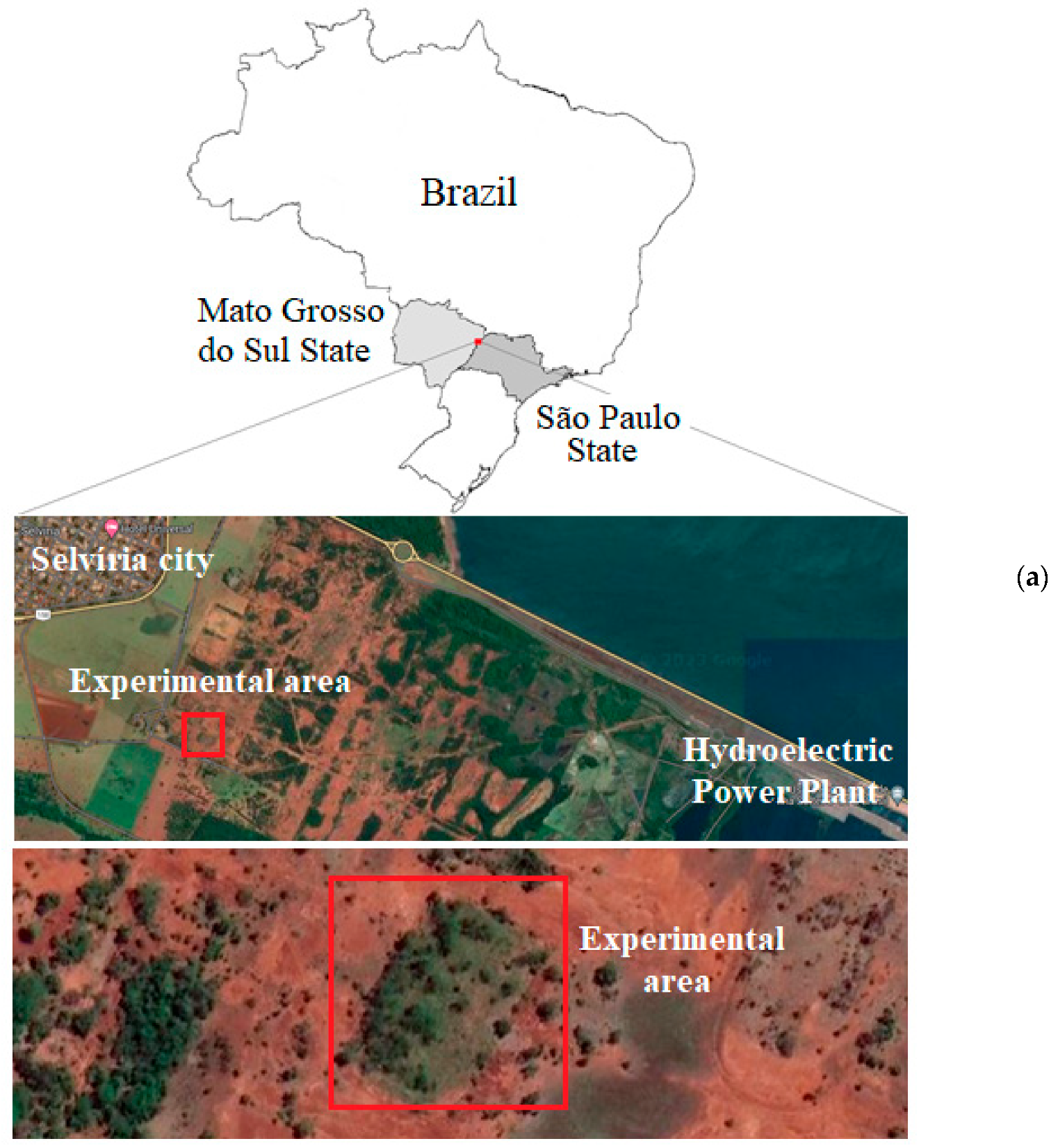
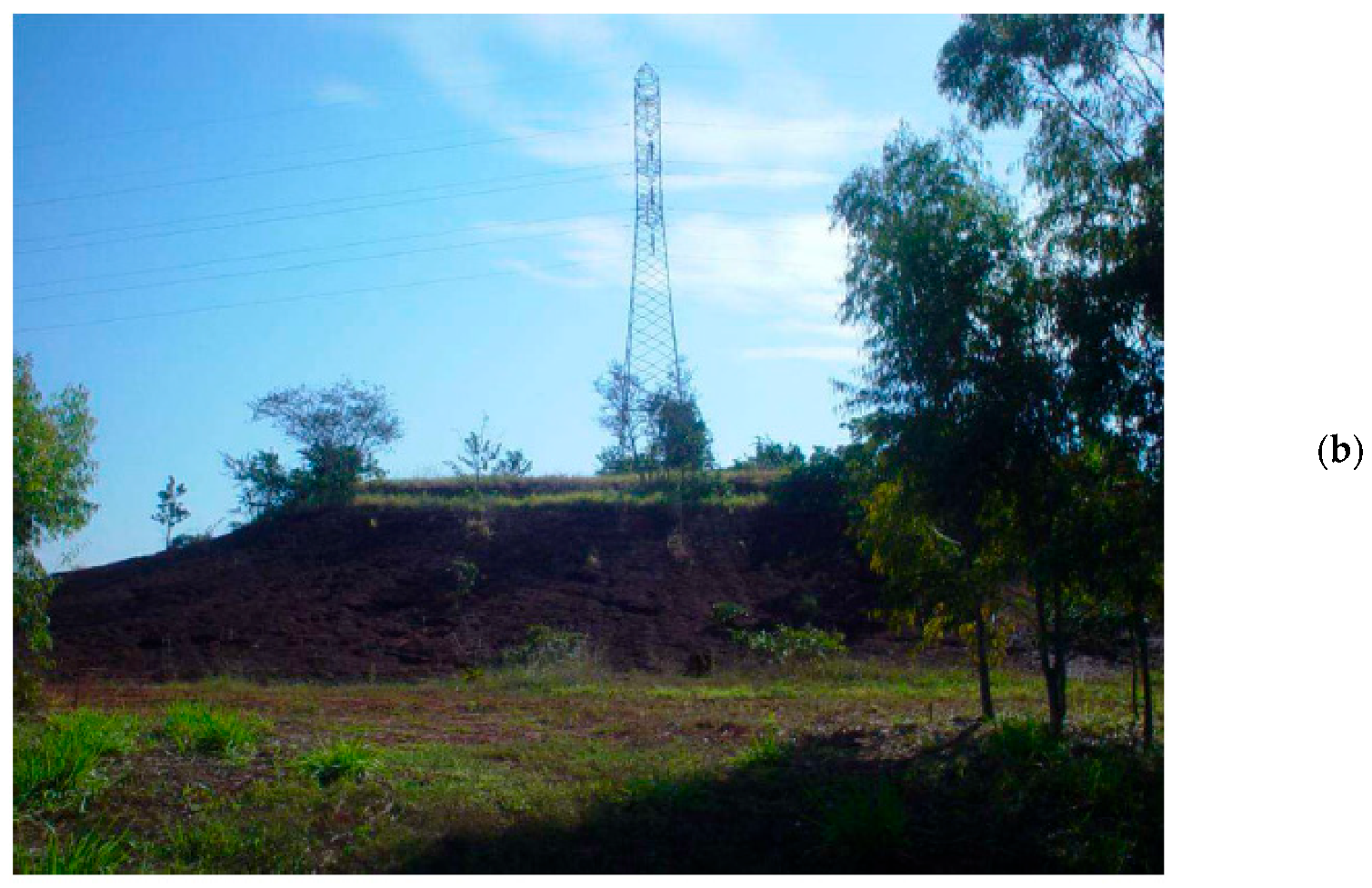
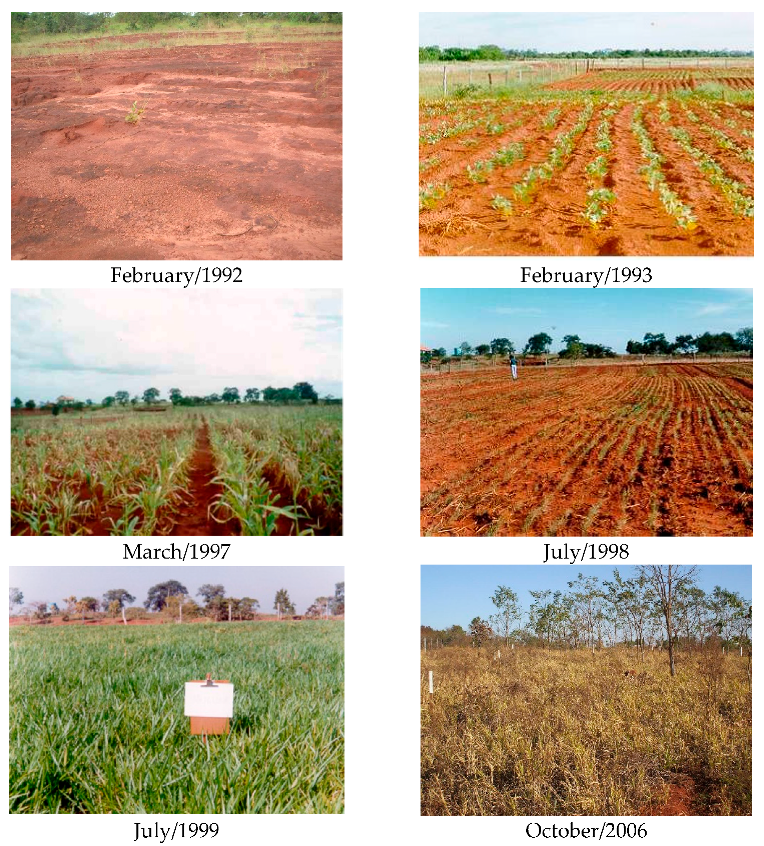
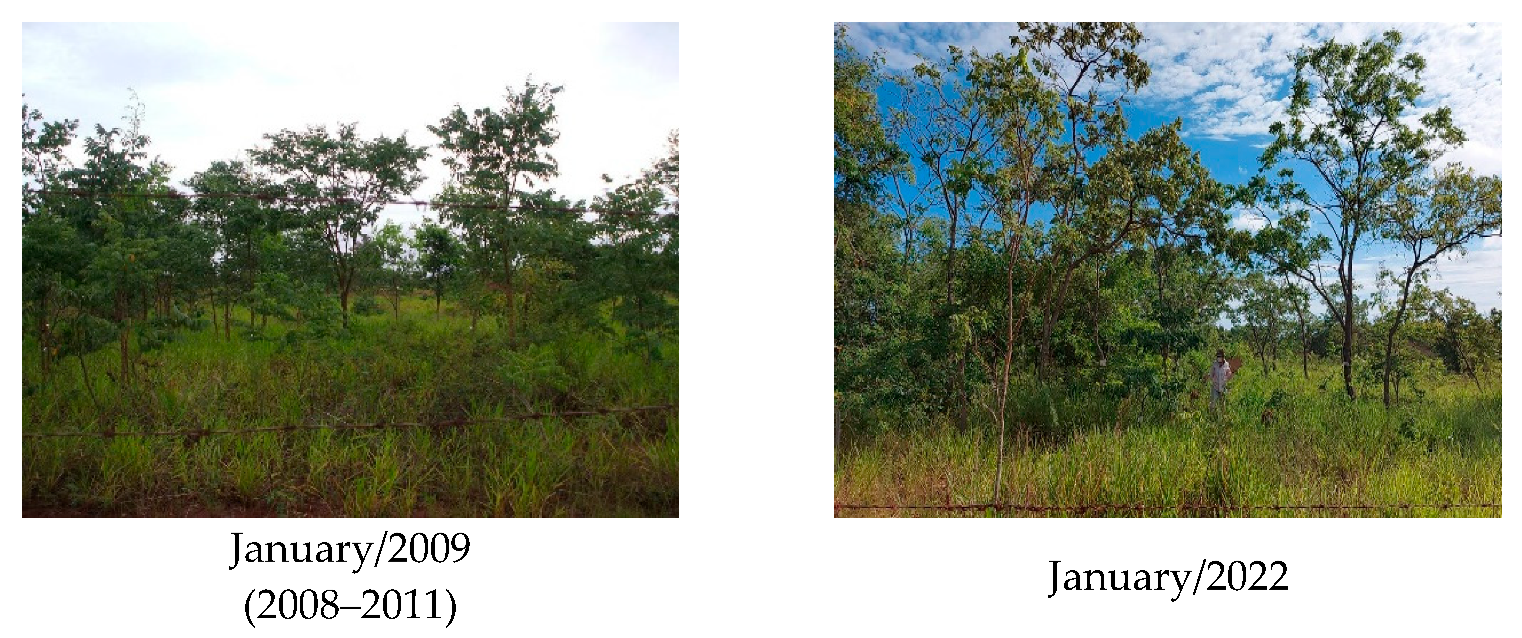

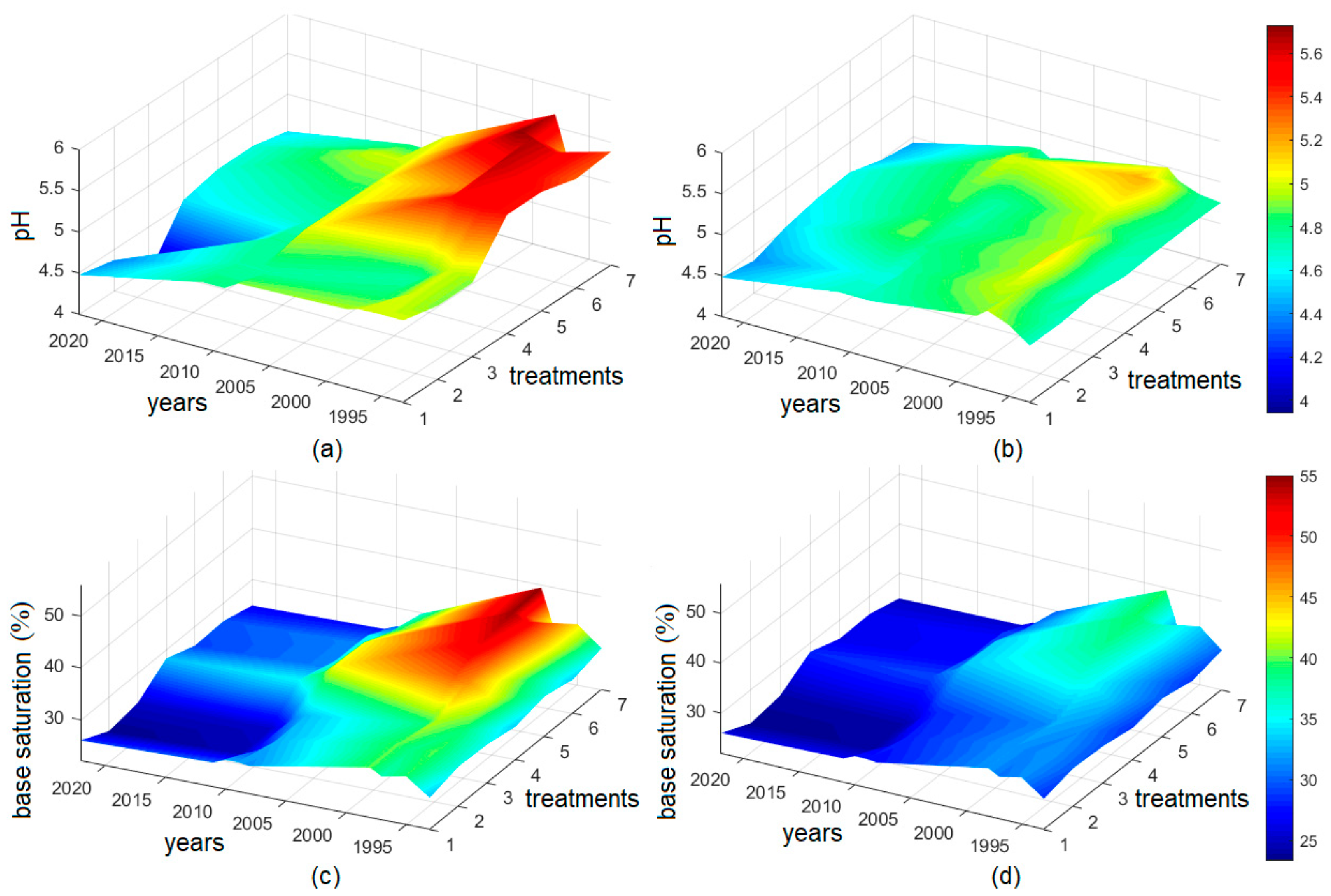
| Layer | Presin | O.M. | pH (CaCl2) | K | Ca | Mg | H + Al | S | CEC | V |
|---|---|---|---|---|---|---|---|---|---|---|
| m | mg·dm−3 | g·dm−3 | mmolc·dm−3 | % | ||||||
| 0.00–0.20 | 1 | 7.0 | 4.0 | 0.2 | 2.0 | 1.0 | 20.0 | 3.2 | 23.2 | 14 |
| 0.20–0.40 | 0 | 4.0 | 4.2 | 0.2 | 2.0 | 1.0 | 20.0 | 3.2 | 23.2 | 14 |
| Treatments | Treatments | Cultures | ||||
|---|---|---|---|---|---|---|
| (1992–1994) | (1994–1997) | 1997 | 1998 | (1999–2008) | (2009–2022) | |
| DS/B | Tilling only, spontaneous vegetation | Tilling only, spontaneous vegetation | Zea mays | Avena atrigosa | U. decumbens | + Native tree species |
| VB/S | Stizolobium aterrimum | Stizolobium aterrimum | ||||
| P/JB/S | Cajanus cajan | Canavalia ensiformis | ||||
| L + VB/S | Lime + Stizolobium aterrimum | Lime + Stizolobium aterrimum | ||||
| L + P/JB/S | Lime + Cajanus cajan | Canavalia ensiformis | ||||
| L + G + VB/S | Lime + gypsum + Stizolobium aterrimum | Lime + gypsum + Stizolobium aterrimum | ||||
| L + G + P/JB/S | Lime + gypsum + Stizolobium aterrimum | Canavalia ensiformis | ||||
| P | P2 | OM | OM2 | pH | pH2 | V | V2 | |
|---|---|---|---|---|---|---|---|---|
| P | - | 0.654 | 0.543 | 0.269 | −0.099 | 0.184 | −0.331 | −0.172 |
| P2 | - | 0.328 | 0.171 | −0.028 | 0.112 | −0.284 | −0.176 | |
| OM | - | 0.807 | −0.326 | 0.124 | −0.290 | −0.073 | ||
| OM2 | - | −0.314 | 0.049 | −0.202 | 0.032 | |||
| pH | - | 0.458 | 0.779 | 0.370 | ||||
| pH2 | - | 0.325 | 0.615 | |||||
| V | - | 0.473 | ||||||
| V2 | - |
| Treatment | P | OM | pH | V | P | OM | pH | V |
|---|---|---|---|---|---|---|---|---|
| 0.00–0.10 m | 0.10–0.20 m | |||||||
| DS/B | 4.29 b | 6.48 | 4.71 b | 32.11 b | 2.13 | 4.30 | 4.52 b | 26.44 |
| VB/S | 4.83 b | 7.84 | 4.65 b | 32.25 b | 2.71 | 5.23 | 4.54 b | 27.62 |
| P/JB/S | 3.61 c | 7.77 | 4.61 b | 33.71 b | 2.30 | 4.58 | 4.63 b | 26.19 |
| L + VB/S | 4.4 b | 7.22 | 5.10 a | 41.45 a | 2.13 | 5.00 | 4.82 a | 34.75 |
| L + P/JB/S | 6.32 a | 7.22 | 5.10 a | 40.38 a | 2.86 | 4.88 | 4.72 a | 30.19 |
| L + G + VB/S | 4.34 b | 7.47 | 5.13 a | 42.81 a | 2.25 | 4.75 | 4.96 a | 32.81 |
| L + G + P/JB/S | 4.51 b | 7.59 | 5.00 a | 39.47 a | 2.40 | 4.77 | 4.74 a | 29.66 |
| Subplot (year) | ||||||||
| 1993 | 2.00 d | 2.46 e | 5.07 a | 43.14 a | 2.00 c | 2.10 d | 4.42 c | 25.32 c |
| 1995 | 1.00 e | 2.21 e | 4.95 a | 46.21 a | 1.00 d | 1.92 d | 4.49 c | 35.28 b |
| 1997 | 1.25 e | 2.25 e | 5.09 a | 37.71 b | 1.46 d | 1.71 d | 4.61 c | 26.87 c |
| 1998 | 2.71 c | 5.39 d | 5.17 a | 42.42 a | 1.96 c | 4.64 c | 5.13 a | 40.53 a |
| 2008 | 7.35 b | 8.28 c | 4.96 a | 33.89 c | 4.00 a | 6.35 b | 4.71 b | 27.00 c |
| 2009 | 8.75 a | 10.64 b | 4.80 b | 32.46 c | 3.28 b | 5.21 c | 4.83 b | 26.92 c |
| 2010 | 7.55 b | 10.64 b | 4.80 b | 32.46 c | 3.28 b | 5.21 c | 4.83 b | 26.92 c |
| 2011 | 8.75 a | 10.64 b | 4.80 b | 32.46 c | 3.28 b | 5.21 c | 4.83 b | 26.92 c |
| 2022 | 2.18 d | 13.82 a | 4.45 c | 36.37 b | 1.33 d | 10.72 a | 4.50 c | 31.22 c |
| F treat (T) | 13.30 * | 1.70 * | 13.51 * | 6.47 * | 1.82 * | 2.98 * | 4.42 * | 2.70 * |
| F year (Y) | 308.16 * | 249.42 * | 11.61 * | 12.70 * | 49.76 * | 88.39 * | 11.51 * | 12.33 * |
| F T × Y | 8.21 * | 1.54 * | 3.02 * | 2.28 * | 1.10 * | 0.91 * | 1.84 * | 1.37 * |
| CV1(%) | 29.83 | 28.74 | 7.71 | 28.96 | 52.27 | 21.49 | 9.50 | 39.77 |
| CV2(%) | 22.03 | 20.03 | 6.85 | 20.90 | 33.55 | 32.99 | 7.41 | 25.92 |
| Treatment/Year | 1993 | 1995 | 1997 | 1998 | 2008 | 2009 | 2010 | 2011 | 2022 |
|---|---|---|---|---|---|---|---|---|---|
| (P) 0.00–0.10 m | |||||||||
| DS/B | 2.00 BC | 1.00 ab | 1.00 ab | 1.75 bB | 7.50 aA | 7.75 ba | 7.75 aA | 7.75 ba | 2.12 AB |
| VB/S | 2.00 BC | 1.00 BC | 1.25 BC | 3.75 ab | 7.75 aA | 8.25 ba | 8.25 aA | 8.25 ba | 3.00 ab |
| P/JB/S | 2.00 BC | 1.00 BC | 1.50 BC | 2.50 BC | 7.00 aA | 5.50 cB | 5.50 bB | 5.50 cB | 2.00 BC |
| L + VB/S | 2.00 BC | 1.00 ab | 1.25 ab | 2.00 bB | 8.00 aA | 7.75 ba | 7.75 aA | 7.75 ba | 2.12 AB |
| L + P/JB/S | 2.00 ad | 1.00 ad | 1.00 ad | 3.75 BC | 8.25 ab | 15.75 aA | 7.41 AB | 15.75 aA | 2.00 ad |
| L + G + VB/S | 2.00 BC | 1.00 BC | 1.50 BC | 2.25 BC | 5.75 bB | 8.25 ba | 8.25 aA | 8.25 ba | 1.87 BC |
| L + G + P/JB/S | 2.00 BC | 1.00 ab | 1.25 ab | 3.00 ab | 7.25 aA | 8.00 ba | 8.00 aA | 8.00 ba | 2.16 AB |
| (P) 0.10–0.20 m | |||||||||
| DS/B | 2.00 BC | 1.00 ab | 1.25 ab | 1.25 ab | 3.75 ba | 3.00 aA | 3.00 aA | 3.00 aA | 1.00 ab |
| VB/S | 2.00 BC | 1.00 ab | 1.25 ab | 2.00 BC | 3.75 ba | 4.25 aA | 4.25 aA | 4.25 aA | 1.66 ab |
| P/JB/S | 2.00 BC | 1.00 ab | 1.75 ab | 2.25 ab | 3.75 ba | 3.00 aA | 3.00 aA | 3.00 aA | 1.00 ab |
| L + VB/S | 2.00 BC | 1.00 ab | 1.00 ab | 1.50 ab | 3.50 ba | 3.00 aA | 3.00 aA | 3.00 aA | 1.25 ab |
| L + P/JB/S | 2.00 BC | 1.00 BC | 2.00 BC | 2.75 ab | 6.25 aA | 3.50 ab | 3.50 ab | 3.50 ab | 1.25 BC |
| L + G + VB/S | 2.00 BC | 1.00 ab | 1.25 ab | 1.75 ab | 3.75 ba | 3.00 aA | 3.00 aA | 3.00 aA | 1.50 ab |
| L + G + P/JB/S | 2.00 BC | 1.00 ab | 1.75 ab | 2.25 ab | 3.25 ba | 3.25 aA | 3.25 aA | 3.25 aA | 1.66 ab |
| (OM) 0.00–0.10 m | |||||||||
| DS/B | 2.00 ad | 2.25 AD | 1.75 ad | 4.75 BC | 7.50 bB | 9.25 ab | 9.25 ab | 9.25 ab | 12.37 ca |
| VB/S | 3.00 BC | 2.75 BC | 3.25 BC | 5.00 BC | 10.25 BC | 10.00 ab | 10.00 ab | 10.00 ab | 16.33 aA |
| P/JB/S | 2.25 AD | 2.75 AD | 2.25 AD | 6.50 BC | 9.00 ab | 11.50 aA | 11.50 aA | 11.50 aA | 12.75 ca |
| L + VB/S | 2.25 aE | 2.00 aE | 2.25 aE | 5.75 AD | 8.00 BC | 10.25 BC | 10.25 BC | 10.25 BC | 14.00 ba |
| L + P/JB/S | 2.00 BC | 2.00 BC | 2.00 BC | 5.25 AB | 9.00 aA | 11.25 aA | 11.25 aA | 11.25 aA | 11.00 ca |
| L + G + VB/S | 2.50 ad | 2.00 ad | 2.25 AD | 5.50 BC | 6.50 BC | 11.50 BC | 11.50 BC | 11.50 BC | 14.00 ba |
| L + G + P/JB/S | 3.25 aE | 1.75 aE | 2.00 aE | 5.00 AD | 7.75 BC | 10.75 ab | 10.75 ab | 10.75 ab | 16.33 aA |
| (OM) 0.10–0.20 m | |||||||||
| DS/B | 2.75 BC | 1.75 BC | 1.25 BC | 4.00 ab | 5.25 bB | 4.75 AB | 4.75 AB | 4.75 AB | 9.50 ba |
| VB/S | 2.00 ad | 2.75 AD | 2.75 AD | 4.50 BC | 8.25 ab | 4.50 BC | 4.50 BC | 4.50 BC | 13.33 aA |
| P/JB/S | 2.00 BC | 2.00 BC | 1.50 BC | 5.50 ab | 5.75 bB | 5.25 AB | 5.25 AB | 5.25 AB | 8.75 ba |
| L + VB/S | 2.00 BC | 1.75 BC | 1.50 BC | 4.50 ab | 7.50 ab | 5.75 AB | 5.75 AB | 5.75 AB | 10.50 ba |
| L + P/JB/S | 2.00 BC | 2.00 BC | 1.00 BC | 4.75 AB | 7.00 BC | 5.75 AB | 5.75 AB | 5.75 AB | 10.00 ba |
| L + G + VB/S | 2.00 BC | 1.75 BC | 2.25 BC | 4.50 ab | 5.50 bB | 5.25 AB | 5.25 AB | 5.25 AB | 11.00 ba |
| L + G + P/JB/S | 2.00 BC | 1.50 BC | 1.75 BC | 4.75 AB | 5.25 bB | 5.25 AB | 5.25 AB | 5.25 AB | 12.00 aA |
| Treatment/Year | 1993 | 1995 | 1997 | 1998 | 2008 | 2009 | 2010 | 2011 | 2022 |
|---|---|---|---|---|---|---|---|---|---|
| (pH) 0.00 a 0.10 m | |||||||||
| DS/B | 4.45 cA | 5.00 aA | 4.42 cA | 4.65 bA | 5.00 aA | 4.80 aA | 4.80 aA | 4.80 aA | 4.47 aA |
| VB/S | 4.50 cA | 4.75 aA | 4.62 cA | 4.62 bA | 4.75 aA | 4.75 aA | 4.75 aA | 4.75 aA | 4.38 aA |
| P/JB/S | 4.30 cB | 4.92 aA | 4.32 cB | 4.75 bA | 5.00 aA | 4.77 aA | 4.77 aA | 4.77 aA | 3.93 bB |
| L + VB/S | 5.95 aA | 5.12 aB | 5.75 aA | 5.47 aA | 5.00 aB | 4.70 aB | 4.70 aB | 4.70 aB | 4.55 aB |
| L + P/JB/S | 5.65 aA | 5.15 aB | 5.65 aA | 5.32 aA | 5.00 aB | 4.82 aB | 4.82 aB | 4.82 aB | 4.65 aB |
| L + G + VB/S | 5.32 bA | 4.87 aB | 5.67 aA | 5.72 aA | 5.00 aB | 4.97 aB | 4.97 aB | 4.97 aB | 4.65 aB |
| L + G + P/JB/S | 5.37 bA | 4.87 aB | 5.20 bA | 5.65 aA | 5.00 aB | 4.80 aB | 4.80 aB | 4.80 aB | 4.55 aB |
| (pH) 0.10 a 0.20 m | |||||||||
| DS/B | 4.30 aA | 4.47 aA | 4.27 bA | 4.57 bA | 4.50 bA | 4.70 aA | 4.70 aA | 4.70 aA | 4.47 aA |
| VB/S | 4.50 aA | 4.77aA | 4.35 bA | 4.67 bA | 4.25 bA | 4.65 aA | 4.65 aA | 4.65 aA | 4.40 aA |
| P/JB/S | 4.25 aB | 4.60 aA | 4.10 bB | 4.65 bA | 5.00 aA | 4.87 aA | 4.87 aA | 4.87 aA | 4.52 aA |
| L + VB/S | 4.40 aB | 4.40 aB | 5.25 aA | 5.45 aA | 4.75 aB | 4.85 aB | 4.85 aB | 4.85 aB | 4.60 aB |
| L + P/JB/S | 4.52 aB | 4.45 aB | 4.35 bB | 5.22 aA | 4.75 aA | 4.87 aA | 4.87 aA | 4.87 aA | 4.62 aB |
| L + G + VB/S | 4.45 aC | 4.40 aC | 5.37 aA | 5.67 aA | 5.00 aB | 5.10 aB | 5.10 aB | 5.10 aB | 4.50 aC |
| L + G + P/JB/S | 4.55 aB | 4.37 aB | 4.57 bB | 5.67 aA | 4.75 aB | 4.77 aB | 4.77 aB | 4.77 aB | 4.43 aB |
| (V%) 0.00 a 0.10 m | |||||||||
| DS/B | 27.25 bB | 45.50 aA | 23.50 bB | 32.50 bB | 32.25 aB | 31.50 aB | 31.50 aB | 31.50 aB | 33.50 aB |
| VB/S | 26.25 bA | 42.00 aA | 31.25 bA | 32.25 bA | 30.25 aA | 31.75 aA | 31.75 aA | 31.75 aA | 33.00 aA |
| P/JB/S | 25.75 bB | 47.25 aA | 26.75 bB | 36.25 bB | 36.75 aB | 33.25 aB | 33.25 aB | 33.25 aB | 31.12 aB |
| L + VB/S | 61.00 aA | 48.00 aB | 48.25 aB | 48.75 aB | 36.50 aC | 30.75 aC | 30.75 aC | 30.75 aC | 38.37 aC |
| L + P/JB/S | 55.50 aA | 46.25 aA | 45.50 aA | 44.25 aA | 32.75 aB | 34.25 aB | 34.25 aB | 34.25 aB | 36.50 aB |
| L + G + VB/S | 54.25 aA | 48.00 aA | 46.25 aA | 51.50 aA | 36.25 aB | 35.50 aB | 35.50 aB | 35.50 aB | 42.62 aB |
| L + G + P/JB/S | 52.00 aA | 46.50 aA | 42.50 aA | 51.50 aA | 32.50 aB | 30.25 aB | 30.25 aB | 30.25 aB | 39.50 aA |
| (V%) 0.10 a 0.20 m | |||||||||
| DS/B | 21.25 aA | 32.75 aA | 19.50 bA | 30.75 bA | 21.50 bA | 27.75 aA | 27.75 aA | 27.75 aA | 29.00 aA |
| VB/S | 29.75 aB | 39.75 aA | 26.00 bB | 36.75 bA | 18.00 bB | 23.00 aB | 23.00 aB | 23.00 aB | 29.33 aB |
| P/JB/S | 19.50 aB | 38.25 aA | 17.50 bB | 31.25 bA | 28.25 aB | 25.25 aB | 25.25 aB | 25.25 aB | 25.25 aB |
| L + VB/S | 28.50 aA | 39.00 aA | 37.25 aA | 46.00 aA | 31.25 aA | 32.50 aA | 32.50 aA | 32.50 aA | 33.25 aA |
| L + P/JB/S | 19.75 aB | 32.00 aA | 22.50 bB | 39.25 bA | 35.25 aA | 29.25 aA | 29.25 aA | 29.25 aA | 35.25 aA |
| L + G + VB/S | 28.50 aB | 31.50 aB | 34.87 aB | 49.25 aA | 31.00 aB | 29.25 aB | 29.25 aB | 29.25 aB | 32.50 aB |
| L + G + P/JB/S | 30.00 aB | 33.75 aB | 30.50 aB | 50.50 aA | 23.75 bC | 21.50 aC | 21.50 aC | 21.50 aC | 34.00 aB |
Disclaimer/Publisher’s Note: The statements, opinions and data contained in all publications are solely those of the individual author(s) and contributor(s) and not of MDPI and/or the editor(s). MDPI and/or the editor(s) disclaim responsibility for any injury to people or property resulting from any ideas, methods, instructions or products referred to in the content. |
© 2023 by the authors. Licensee MDPI, Basel, Switzerland. This article is an open access article distributed under the terms and conditions of the Creative Commons Attribution (CC BY) license (https://creativecommons.org/licenses/by/4.0/).
Share and Cite
Lourencetti, J.; Bonini, C.d.S.B.; Andreotti, M.; Alves, M.C.; Bonini Neto, A.; Santos, M.A.; Barretto, V.C.d.M.; de Figueredo, R.W.R. Evolution of Soil Chemical Fertility in an Area under Recovery for 30 Years with Anthropic Intervention. Sustainability 2023, 15, 10344. https://doi.org/10.3390/su151310344
Lourencetti J, Bonini CdSB, Andreotti M, Alves MC, Bonini Neto A, Santos MA, Barretto VCdM, de Figueredo RWR. Evolution of Soil Chemical Fertility in an Area under Recovery for 30 Years with Anthropic Intervention. Sustainability. 2023; 15(13):10344. https://doi.org/10.3390/su151310344
Chicago/Turabian StyleLourencetti, Josiane, Carolina dos Santos Batista Bonini, Marcelo Andreotti, Marlene Cristina Alves, Alfredo Bonini Neto, Melissa Alexandre Santos, Vitor Correa de Mattos Barretto, and Roberth Wicleff Rodrigues de Figueredo. 2023. "Evolution of Soil Chemical Fertility in an Area under Recovery for 30 Years with Anthropic Intervention" Sustainability 15, no. 13: 10344. https://doi.org/10.3390/su151310344
APA StyleLourencetti, J., Bonini, C. d. S. B., Andreotti, M., Alves, M. C., Bonini Neto, A., Santos, M. A., Barretto, V. C. d. M., & de Figueredo, R. W. R. (2023). Evolution of Soil Chemical Fertility in an Area under Recovery for 30 Years with Anthropic Intervention. Sustainability, 15(13), 10344. https://doi.org/10.3390/su151310344










